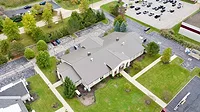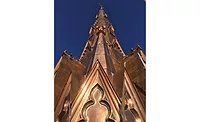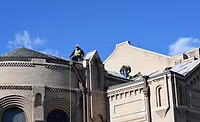Project Profile: Copper Roofing Restores Canadian Church
Design team turned to copper for its sustainable and reliable qualities

St. Elias Ukrainian Catholic Church, Brampton Ontario. Photo by Janet Kimber

St. Elias Ukrainian Catholic Church, Brampton Ontario. Photo by Janet Kimber

St. Elias Ukrainian Catholic Church, Brampton Ontario. Photo by Janet Kimber

St. Elias Ukrainian Catholic Church, Brampton Ontario. Photo by Janet Kimber

St. Elias Ukrainian Catholic Church, Brampton Ontario. Photo by Janet Kimber
BRAMPTON, Ontario — Just a few miles outside of Toronto stands the St. Elias Ukrainian Catholic Church in Brampton, Ontario.
Originally constructed in 1995, the church was modeled after the Western Ukrainian architectural style known as “Boyko,” which uses distinctive wooden architectural patterns with domes arranged in a single line.
Devastated by an accidental fire in 2014, the church was damaged beyond repair. Following an outpouring of support from the local community, the Brampton parish rebuilt the church with two overarching goals: restore the church’s purity and utilize sustainable building materials and practices.
Restoring the Church’s Purity with Copper
Even before the fire, the St. Elias Ukrainian Catholic Church was staring down a challenging situation born from the original roof installation. A lack of funding, installation mistakes and valuing engineering tactics left the roofing system and building without all the elements originally specified by the design team. As a result, weathering and time chewed away at these weak points.
“During the church’s first winter, snow was already finding its way into the building through improperly sealed sections of the roof domes,” said Adam Zimmerman, owner of Brooklyn firm Zimmerman Workshop Architecture + Design and lead architect of the St. Elias restoration project. “This coupled with several other cost cutting methods generated huge energy waste and added unplanned, unsustainable strain on the domes.”
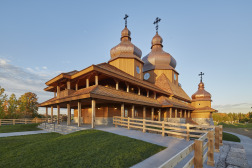 Fast-forward though 20 years of harsh Canadian winters and the original cedar shake roofing system required a full roof replacement, including its five massive domes covered in cedar shingles. Before the church had an opportunity to address these issues, the fire struck and destroyed nearly the entire church.
Fast-forward though 20 years of harsh Canadian winters and the original cedar shake roofing system required a full roof replacement, including its five massive domes covered in cedar shingles. Before the church had an opportunity to address these issues, the fire struck and destroyed nearly the entire church.
The parish immediately sought to rebuild its place of worship with a more sustainable building material, noted Zimmerman. Looking to continue the traditional timber aspects of “Boyko” architecture, while also incorporating more long-term solution materials to avoid another roofing calamity in the future, the church decided to upgrade the domes to copper.
“We looked at a diversity of roofing material options such as synthetics, standing seam, another cedar shake system and copper,” said Zimmerman. “Nothing stuck as well as copper. The parish wanted to not only return to the spirit of purity that ‘Boyko’ is based on, but also ensure a sustainable roofing material was installed. For this, copper was the clear choice.”
A Sustainable Material
Copper is one of the most durable roofing materials known to man and has been used as such for centuries, especially for places of worship. Its pleasing aesthetic qualities allow designers to achieve their visual aspirations while also meeting important environmental objectives. But going green is not just a trend. With an increase in demand for natural resources, many builders are realizing the importance of sustainable building principles. Since copper is highly corrosion-resistant, the metal can last up to 100 years in harsh environmental conditions, such as an Ontario winter. Additionally, the sheet copper used for roofing systems is often created largely from scrap material and it can be used over and over with no loss of its engineering properties, making it a wise choice for sustainability building projects.
The metal’s durability results from its ability to form a naturally occurring and tenacious patina that protects the material, which ensures a long service life. Upon installation, copper roofing systems appear shiny and salmon pink, but typically when left unprotected, copper and its principal architectural alloys naturally oxidize. This chemical reaction causes the metal to change in hue to different russet brown shades and then light and dark chocolate browns. From there, it will develop a dark, dull-slate gray or dull-black from which the ultimate blue-green or gray-green patinas emerge. It is best to allow copper and its alloys to adapt to local conditions and circumstances naturally to ensure the protective chemical reaction occurs.
Installing the Domes
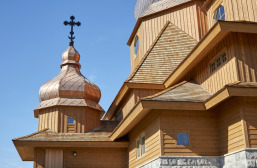 Each of the massive copper domes was a tremendous undertaking and needed to be built on the ground and then hoisted into place using a 260 ton-crane. Unlike the original cedar shake used to clad the domes, the copper required specific bending and forming, however the resulting durability and aesthetics made it worthwhile.
Each of the massive copper domes was a tremendous undertaking and needed to be built on the ground and then hoisted into place using a 260 ton-crane. Unlike the original cedar shake used to clad the domes, the copper required specific bending and forming, however the resulting durability and aesthetics made it worthwhile.
The dome frames are built from a hybrid of glulam, stick frame, and curved plywood. The largest of the five domes weigh over 18,000 kg (just under 20 tons) and bears directly on a 13x13 meter glulam space-frame truss. The domes are clad in diamond shaped copper pieces measuring 24 inches high and 18 inches wide.
The natural beauty of the newly installed copper domes will provide an unrivaled service longevity, as would all properly designed and installed copper systems. This ensures that designers and building owners not only achieve their visual aspirations and performance specifications, but are also able to meet their environmental and cost-performance goals. While nobody can predict exactly what the building and construction market will do in the future, it’s evident that copper will remain an important building material for years to come.
Since its completion, the St. Elias Ukrainian Catholic Church has won the Copper Development Association’s (CDA) 2018 North American Copper in Architecture (NACIA) award for its dome construction. Additional information about architectural copper can be found in the Copper in Architecture Handbook, which is available at www.copper.org.
Looking for a reprint of this article?
From high-res PDFs to custom plaques, order your copy today!



